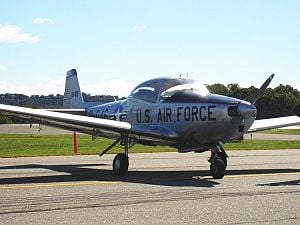
Navion: The Sky's Stalwart Post-War Wonder
First introduced in 1946, the Navion aircraft is a symbol of the tenacity and ingenuity of post-WWII American aeronautical engineering. Born from the brilliant minds at North American Aviation (NAA), the Navion was designed for the general aviation market as a four-seat, single-engine monoplane, boasting a balance of speed, convenience, and affordability that made it an instant classic.
HISTORY: From Warplanes to Weekend Flyers
North American Aviation, renowned for their P-51 Mustang, created the Navion intending to capture the anticipated post-war boom in civilian aviation. While the civilian aviation boom was not as large as expected, the Navion's excellent performance and versatile usage led to its continued production by several different companies, long past NAA's involvement. The Navion's story is a testament to adaptability, showing an aircraft's journey from its conception as a civilian plane to military use and back again.
DESIGN: A Compact Powerhouse
With a wingspan of 33.4 feet and a length of 27.9 feet, the Navion is not a particularly large aircraft, but it is robust. Originally designed to accommodate four people, it balances comfort with space efficiency. The aircraft’s empty weight is around 1,875 pounds, and it has a maximum takeoff weight of 2,750 pounds, showcasing its compact yet powerful nature.
PERFORMANCE: Punching Above its Weight
For an aircraft of its size, the Navion's performance is impressive. It has a top speed of 187 knots, and a range of over 800 miles. Its service ceiling is approximately 16,000 feet, and it boasts respectable fuel efficiency for an aircraft of its era and design.
TECHNOLOGY: A Perfect Blend of Old and New
Despite its vintage, the Navion is no slouch when it comes to technology. Early models were equipped with the then-state-of-the-art avionics and safety systems. Later iterations and restored models often feature updated avionics, marrying the aircraft's classic design and robust performance with modern navigation and safety systems.
VARIANTS: Adaptation and Evolution
Throughout its life, the Navion has seen multiple variants. The original Rangemaster G model was notable for a larger cabin and increased fuel capacity. Later models developed by Ryan Aeronautical saw military service as liaison aircraft during the Korean War, under the name L-17.
OPERATORS: From Air Forces to Airfields
Notable operators of the Navion include the United States Air Force and Army, which used the aircraft during the Korean War for liaison and light utility duties. Today, the Navion remains popular among general aviation pilots for its reliability, performance, and timeless appeal.
In conclusion, the Navion's storied history, robust design, and continued relevance underscore its significance in aviation history. From its origins in the heady post-war days to its continued use in the present, the Navion stands as a testament to the enduring appeal of well-designed, versatile aircraft.
Interested in the Navion? Share this post with other aviation enthusiasts, and spread the word about this remarkable aircraft.
Navion Detailed Specifications
| Characteristics | Details |
|---|---|
| Manufacturer | North American Aviation, Ryan Aeronautical, others |
| Introduction | 1946 |
| Role | General Aviation |
| Crew | One |
| Passengers | Three |
| Length | 27.9 feet |
| Wingspan | 33.4 feet |
| Height | 9.3 feet |
| Empty weight | 1,875 pounds |
| Max takeoff weight | 2,750 pounds |
| Powerplant | One × Continental E185 horizontally opposed six-cylinder air-cooled engine, 185 hp |
| Maximum speed | 187 knots |
| Range | 800 miles |
| Service ceiling | 16,000 feet |
This article uses material from various web resources and Wikipedia article, released under the Creative Commons Attribution-Share-Alike License 3.0.

